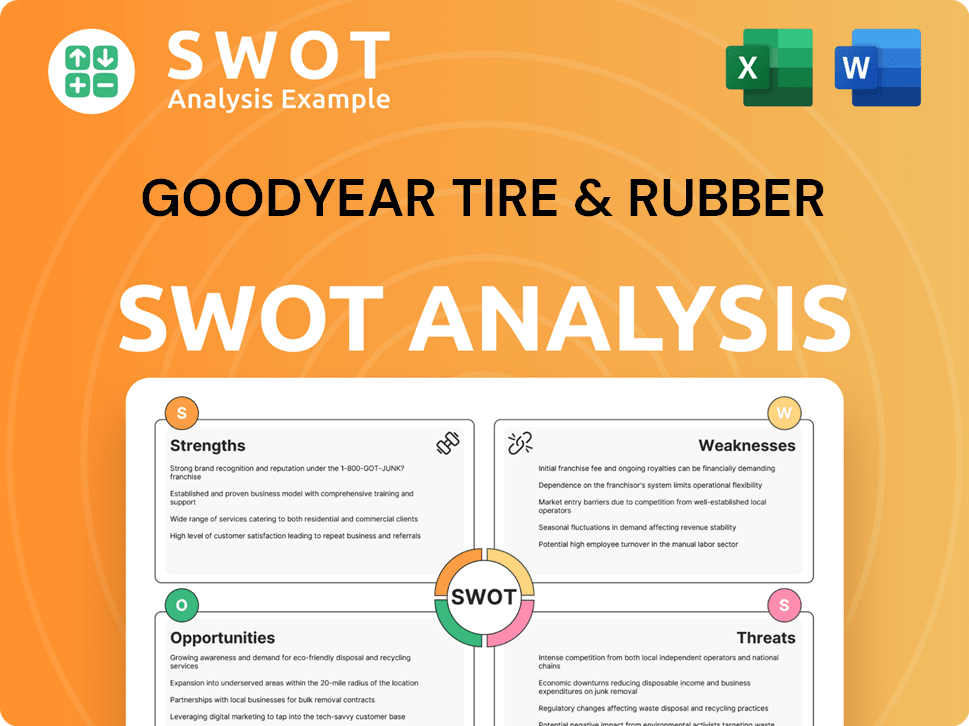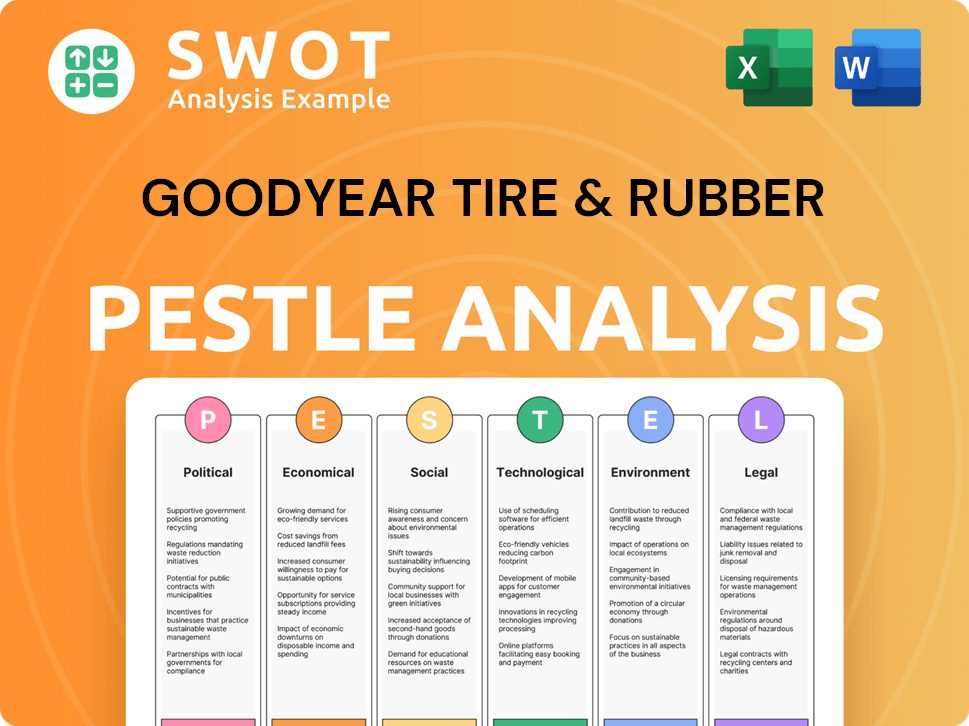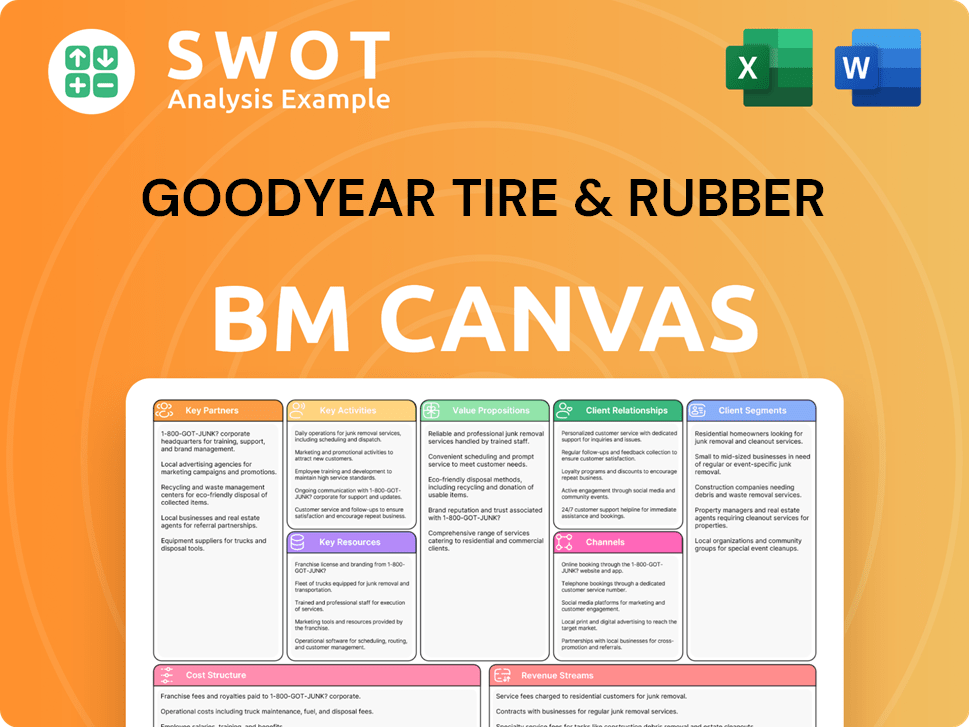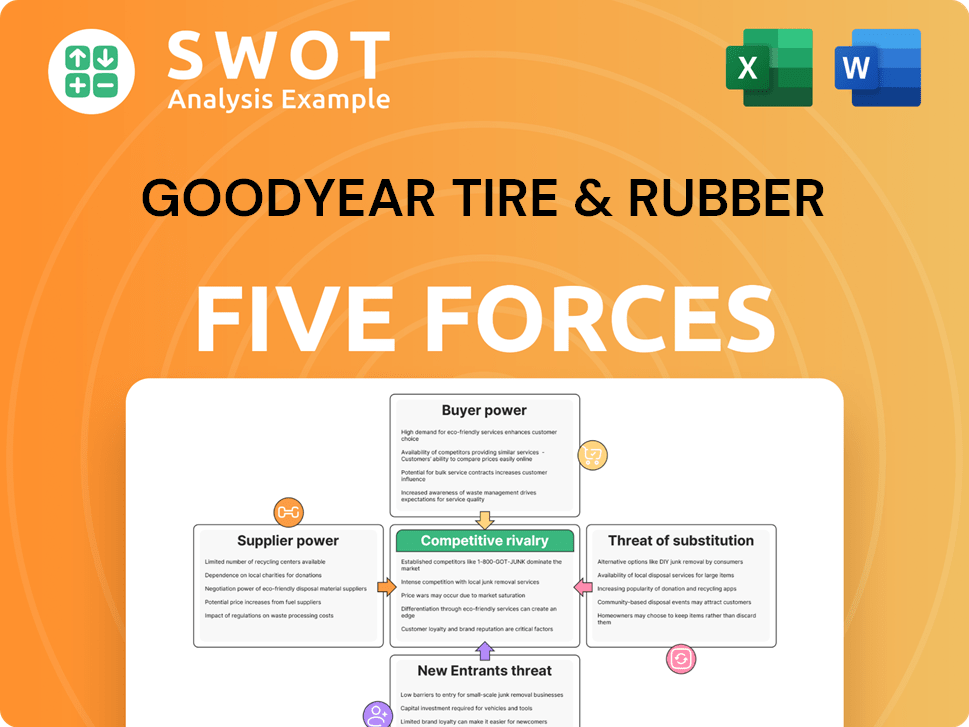Goodyear Tire & Rubber Bundle
How Does Goodyear Thrive in the Tire Industry?
Goodyear Tire & Rubber Company, a cornerstone of global transportation, has been shaping the way we move since 1898. This Goodyear Tire & Rubber SWOT Analysis will help you understand how this Tire Company has consistently innovated and adapted to meet the evolving demands of the automotive and industrial sectors. Its influence spans across various modes of transport, making it a critical player in the global economy.

Understanding Goodyear's operations is essential for anyone interested in the Tire Manufacturing industry. From passenger vehicles to heavy machinery, Goodyear's products are everywhere. This exploration will uncover the secrets behind Goodyear's success, from its extensive product portfolio to its strategic approach in a competitive global market. Learn about Goodyear tire technology and how it impacts its performance ratings.
What Are the Key Operations Driving Goodyear Tire & Rubber’s Success?
The core of the business for the Goodyear Tire & Rubber Company revolves around designing, manufacturing, distributing, and marketing tires and related products globally. This encompasses a wide range of tires for various vehicles, including passenger cars, light trucks, commercial trucks, buses, and off-the-road equipment. The company serves both the original equipment manufacturer (OEM) market, supplying tires for new vehicles, and the replacement market, where consumers and businesses purchase tires for existing vehicles.
The operational structure of the Tire Company is highly integrated, starting with research and development (R&D) to innovate tire technologies. Manufacturing is a global endeavor, utilizing advanced production techniques and materials. The supply chain involves sourcing raw materials like natural rubber and synthetic rubber, managed through a global network. Logistics and distribution are complex, involving a vast network to deliver products to various customers worldwide.
The company's value proposition lies in its ability to provide superior tire performance, durability, and safety. This is achieved through continuous innovation, advanced manufacturing processes, and an extensive distribution network. This approach allows Goodyear to effectively serve diverse markets and customer needs, maintaining its competitive edge in the tire industry.
Goodyear offers a diverse range of tires for passenger cars, light trucks, commercial trucks, buses, and off-the-road equipment. They also provide tire-related services, including tire installation, repair, and maintenance. The company's product portfolio includes various tire models designed for different driving conditions and vehicle types.
Goodyear operates manufacturing facilities worldwide, ensuring global reach and efficient production. The company invests heavily in R&D to improve tire performance, fuel efficiency, and safety. They maintain a robust supply chain and distribution network to meet customer demands efficiently.
Goodyear serves both original equipment manufacturers (OEMs) and the replacement market. Their customers include individual consumers, commercial fleets, and vehicle manufacturers. The company's broad customer base supports its global presence and market stability.
Goodyear's competitive advantages include its brand recognition, global manufacturing footprint, and technological innovation. The company's extensive distribution network and strong customer relationships further enhance its market position. Continuous innovation in tire technology helps Goodyear stay ahead of competitors.
In 2024, Goodyear's net sales were approximately $19.9 billion. The company's global presence includes manufacturing facilities in multiple countries, ensuring a broad distribution network. Goodyear's commitment to innovation is reflected in its significant R&D investments, aimed at improving tire performance and sustainability.
- Goodyear's global market share in the tire industry is significant, with a strong presence in both the OEM and replacement markets.
- The company's focus on innovation has led to advancements in tire technology, enhancing fuel efficiency and safety.
- Goodyear's supply chain is optimized for efficiency, ensuring timely delivery of products to customers worldwide.
- For more details on Goodyear's target market, you can read about it in this article: Target Market of Goodyear Tire & Rubber.
Goodyear Tire & Rubber SWOT Analysis
- Complete SWOT Breakdown
- Fully Customizable
- Editable in Excel & Word
- Professional Formatting
- Investor-Ready Format

How Does Goodyear Tire & Rubber Make Money?
The primary revenue stream for the Goodyear Tire & Rubber Company revolves around the sale of tires and related services. The Tire Company generates income from various segments, including the Americas, Europe, Middle East, Africa (EMEA), and Asia Pacific. These sales are split between the original equipment (OE) market and the replacement market.
Goodyear's main source of revenue comes from selling tires for passenger vehicles, light trucks, commercial trucks, buses, motorcycles, aircraft, and off-the-road applications. Additionally, the company offers tire-related services such as repair and maintenance through its global network of retail and service centers. In 2023, Goodyear reported net sales of $20.06 billion.
Goodyear Products uses various strategies to generate revenue, including tiered pricing for its different product lines, from premium to economy options. They also engage in cross-selling and leverage a global distribution network to maximize sales. Changes in revenue sources depend on global automotive production, raw material costs, and consumer demand.
Goodyear employs several monetization strategies to boost its revenue. These strategies include tiered pricing, cross-selling, and leveraging its extensive global distribution network. The company focuses on offering high-value products and services to meet changing market demands.
- Tiered Pricing: Goodyear offers a range of tires at different price points to cater to various customer segments.
- Cross-Selling: They offer complementary services and products alongside tire sales.
- Global Distribution: Goodyear uses its network of company-owned stores and independent dealers.
- Market Dynamics: Revenue changes are influenced by automotive production, raw material costs, and consumer preferences.
Goodyear Tire & Rubber PESTLE Analysis
- Covers All 6 PESTLE Categories
- No Research Needed – Save Hours of Work
- Built by Experts, Trusted by Consultants
- Instant Download, Ready to Use
- 100% Editable, Fully Customizable

Which Strategic Decisions Have Shaped Goodyear Tire & Rubber’s Business Model?
The operational and financial trajectory of the Goodyear Tire & Rubber Company has been shaped by significant milestones and strategic shifts. A key initiative is the Goodyear Forward plan, announced in late 2023, which aims to optimize the company's portfolio, generate cash, and enhance shareholder value. This plan involves divesting assets, such as the Dunlop brand in Australia and New Zealand, and the off-the-road (OTR) products business, with the proceeds intended to reduce debt.
The company has navigated operational challenges, including supply chain disruptions and inflationary pressures on raw materials and transportation. In response, Goodyear has implemented pricing adjustments and efficiency improvements across its manufacturing and logistics operations to mitigate these impacts. For instance, in the fourth quarter of 2023, the company reported a segment operating income of $197 million, influenced by lower volumes and higher selling, administrative, and general expenses, partially offset by favorable price/mix.
Goodyear's competitive advantages are multifaceted. Its brand strength, built over a century of innovation and quality, fosters significant customer loyalty. Technological leadership in tire development, particularly in areas like sustainable materials and smart tire technologies, provides a distinct edge. The company's global scale and extensive manufacturing footprint allow for economies of scale, reducing production costs and increasing efficiency. Furthermore, its vast distribution network, encompassing both company-owned retail outlets and independent dealers, ensures broad market reach.
Goodyear has a rich history, marked by innovations and expansions. Key milestones include the development of the first pneumatic tire for automobiles and significant advancements in tire technology.
The Goodyear Forward plan is a pivotal strategic move, focusing on portfolio optimization and debt reduction. Other strategic decisions include investments in electric vehicle tires and sustainable tire solutions.
Goodyear's brand strength, technological leadership, and global scale provide a competitive edge. Its extensive distribution network and focus on innovation further enhance its position in the market.
In Q4 2023, Goodyear reported a segment operating income of $197 million. The company is focused on improving profitability through pricing adjustments and efficiency gains. The company's revenue for 2023 was approximately $19.9 billion.
Goodyear's competitive advantages are built on brand recognition, technological innovation, and global presence. The company continues to adapt to market trends, such as the growing demand for electric vehicle tires and sustainable solutions.
- Brand Strength: Built over a century, fostering customer loyalty.
- Technological Leadership: Focus on sustainable materials and smart tire technologies.
- Global Scale: Extensive manufacturing footprint for cost efficiency.
- Distribution Network: Broad market reach through diverse channels.
Goodyear Tire & Rubber Business Model Canvas
- Complete 9-Block Business Model Canvas
- Effortlessly Communicate Your Business Strategy
- Investor-Ready BMC Format
- 100% Editable and Customizable
- Clear and Structured Layout

How Is Goodyear Tire & Rubber Positioning Itself for Continued Success?
The Goodyear Tire & Rubber Company holds a significant position in the global tire market, standing as one of the largest tire manufacturers. It competes with major players like Michelin, Bridgestone, and Continental, boasting a strong brand reputation and extensive customer loyalty. With a broad international presence, the Tire Company operates and sells its products across North America, Europe, Asia Pacific, and Latin America.
However, Goodyear faces several challenges. These include volatile raw material prices, intense competition leading to pricing pressures, and the need to adapt to evolving environmental standards and vehicle technology shifts, such as the rise of electric vehicles. Financial risks are also present, including a substantial debt load.
Goodyear's strong brand recognition and global reach support its prominent position in the tire industry. The company's extensive distribution network and diverse product offerings cater to a wide range of vehicles and customer needs. Continuous innovation in tire technology helps maintain its competitive edge.
Fluctuations in raw material costs, particularly for natural rubber and petrochemicals, pose a significant risk. Intense competition and pricing pressures within the tire industry can impact profitability. Regulatory changes and the shift towards electric vehicles also present challenges.
Goodyear is focused on its Goodyear Forward plan to streamline operations and improve financial performance. The company plans to concentrate on premium product segments, optimize its global footprint, and leverage technological advancements. The goal is to deliver superior products and services.
As of December 31, 2023, Goodyear's debt load was approximately $7.3 billion. The company is working to reduce leverage and improve its competitive position through the Goodyear Forward plan. For the full year 2023, Goodyear reported net sales of $19.4 billion.
Goodyear is implementing the Goodyear Forward plan, which includes streamlining operations and reducing costs. The company is focused on innovation in sustainable tires and connected tire technologies to meet evolving market demands. Leadership is committed to enhancing the company's competitive position.
- Focus on premium product segments and optimizing global footprint.
- Leveraging technological advancements for superior products and services.
- Continued progress in the Goodyear Forward plan throughout 2024.
- Commitment to sustainable tire technologies and connected tire systems.
The Rubber Company's future hinges on its ability to execute its strategic initiatives, particularly the Goodyear Forward plan. By focusing on premium products, optimizing its global footprint, and leveraging technological advancements, Goodyear Products aims to maintain its competitive edge. For a deeper understanding of the competitive landscape, see the Competitors Landscape of Goodyear Tire & Rubber.
Goodyear Tire & Rubber Porter's Five Forces Analysis
- Covers All 5 Competitive Forces in Detail
- Structured for Consultants, Students, and Founders
- 100% Editable in Microsoft Word & Excel
- Instant Digital Download – Use Immediately
- Compatible with Mac & PC – Fully Unlocked

Related Blogs
- What are Mission Vision & Core Values of Goodyear Tire & Rubber Company?
- What is Competitive Landscape of Goodyear Tire & Rubber Company?
- What is Growth Strategy and Future Prospects of Goodyear Tire & Rubber Company?
- What is Sales and Marketing Strategy of Goodyear Tire & Rubber Company?
- What is Brief History of Goodyear Tire & Rubber Company?
- Who Owns Goodyear Tire & Rubber Company?
- What is Customer Demographics and Target Market of Goodyear Tire & Rubber Company?
Disclaimer
All information, articles, and product details provided on this website are for general informational and educational purposes only. We do not claim any ownership over, nor do we intend to infringe upon, any trademarks, copyrights, logos, brand names, or other intellectual property mentioned or depicted on this site. Such intellectual property remains the property of its respective owners, and any references here are made solely for identification or informational purposes, without implying any affiliation, endorsement, or partnership.
We make no representations or warranties, express or implied, regarding the accuracy, completeness, or suitability of any content or products presented. Nothing on this website should be construed as legal, tax, investment, financial, medical, or other professional advice. In addition, no part of this site—including articles or product references—constitutes a solicitation, recommendation, endorsement, advertisement, or offer to buy or sell any securities, franchises, or other financial instruments, particularly in jurisdictions where such activity would be unlawful.
All content is of a general nature and may not address the specific circumstances of any individual or entity. It is not a substitute for professional advice or services. Any actions you take based on the information provided here are strictly at your own risk. You accept full responsibility for any decisions or outcomes arising from your use of this website and agree to release us from any liability in connection with your use of, or reliance upon, the content or products found herein.